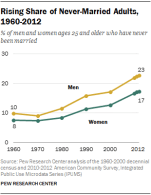 A fact sheet prepared for the Council on Contemporary Families to mark Unmarried and Single Americans Week, September 17-23, by Bella DePaulo, Ph.D., Academic Affiliate, Psychological & Brain Sciences, University of California, Santa Barbara.
A fact sheet prepared for the Council on Contemporary Families to mark Unmarried and Single Americans Week, September 17-23, by Bella DePaulo, Ph.D., Academic Affiliate, Psychological & Brain Sciences, University of California, Santa Barbara.
September 17-23, 2017 is Unmarried and Single Americans Week. Today, more than 45 percent of all Americans 18 and older are unmarried (divorced, widowed, or never-married), up from 28 percent in 1970. Contrary to stereotypes, single people typically lead happy and healthy lives. They maintain vital ties to friends, family, children, and communities, often providing practical and emotional support to others.
The proportion of unmarried Americans has hit an all-time high.
- Of adults 18 and older, 110.6 million are divorced, widowed, or have never married. Never-married people are the biggest group of unmarried Americans, accounting for 63.5 percent. Another 23.1 percent are divorced and the other 13.4 percent are widowed.
- Half the labor force is comprised of unmarried individuals.
- Only 14.6 million of these unmarried Americans (7.3 million couples) are cohabiting with a romantic partner. Of those, 867,000 are cohabiting with a same-sex partner. By contrast, 96 million Americans 18 and older are neither married nor cohabiting with a romantic partner.
- The median age at which people first marry, among those who do marry, has reached an all-time high of 29.5 for men and 27.4 for women. And researchers predict that 1 in 4 of today’s young adults will reach age 50 without ever having married.
- The age at which people marry has become much more spread out than the past, so some of these folks will go on to marry, but record numbers of American spend the majority of their adult lives outside marriage. It is time to stop seeing singlehood as a temporary way-station.
Like everybody else, unmarried Americans live in many different kinds of households and communities.
- More Americans than ever before, 35.4 million, live alone. That is more than twice the number of unmarried Americans who are cohabiting with a romantic partner. Lone households are now more common than married-couple households containing children.
- Most unmarried Americans, though, do not live alone. Their living arrangements are more diverse than ever. Some single people, including single parents, live with family in multigenerational or extended family households. Others live with friends, or with friends and family. Single mothers sometimes share homes with other single mothers. Unmarried Americans also live in cohousing communities and other neighborhoods where people commit to being part of a community.
Single people are often stereotyped as isolated and lonely and depressed. In fact, the majority of single Americans live happy and healthy lives.
- One of the most important protective factors against loneliness is having friends. And single people have more friends than married people. They also provide more practical help and emotional support to their parents, siblings, friends, and neighbors.
- People who marry are typically just as healthy, and sometimes even a bit healthier, when they are single than after they marry.
- People who marry and stay married sometimes experience an increase in satisfaction with their lives in the early years of their marriage, but that honeymoon effect usually does not last. Over time, people who marry are typically no happier than they were when they were single.
- A study of more than 16,000 people found that only 10 percent experienced a significant increase in well-being after marriage, while 6 percent experienced a sharp decrease. The rest stayed the same.
- Among women 57 and older, women who are married, cohabiting, dating, or single but not dating experience similar levels of loneliness, depression, and stress. For men, when there are differences, they favor those who are cohabiting rather than those who are married; men who are dating are no better off than single men without partners.
Unmarried Americans play important roles in raising the next generation.
- More than 35 percent of women who give birth in a given year are unmarried.
- Three out of every 10 grandparents with primary responsibility for their grandchildren are unmarried. That amounts to about 790,000 single-grandparents with primary care-giving responsibilities.
- Unmarried people who are not parents also play important roles in the lives of children – for example, as aunts and uncles, teachers, coaches, and role models.
For more information, contact Dr. Bella DePaulo at belladepaulo@gmail.com and read her blog: Living Single, at Psychology Today.

Comments